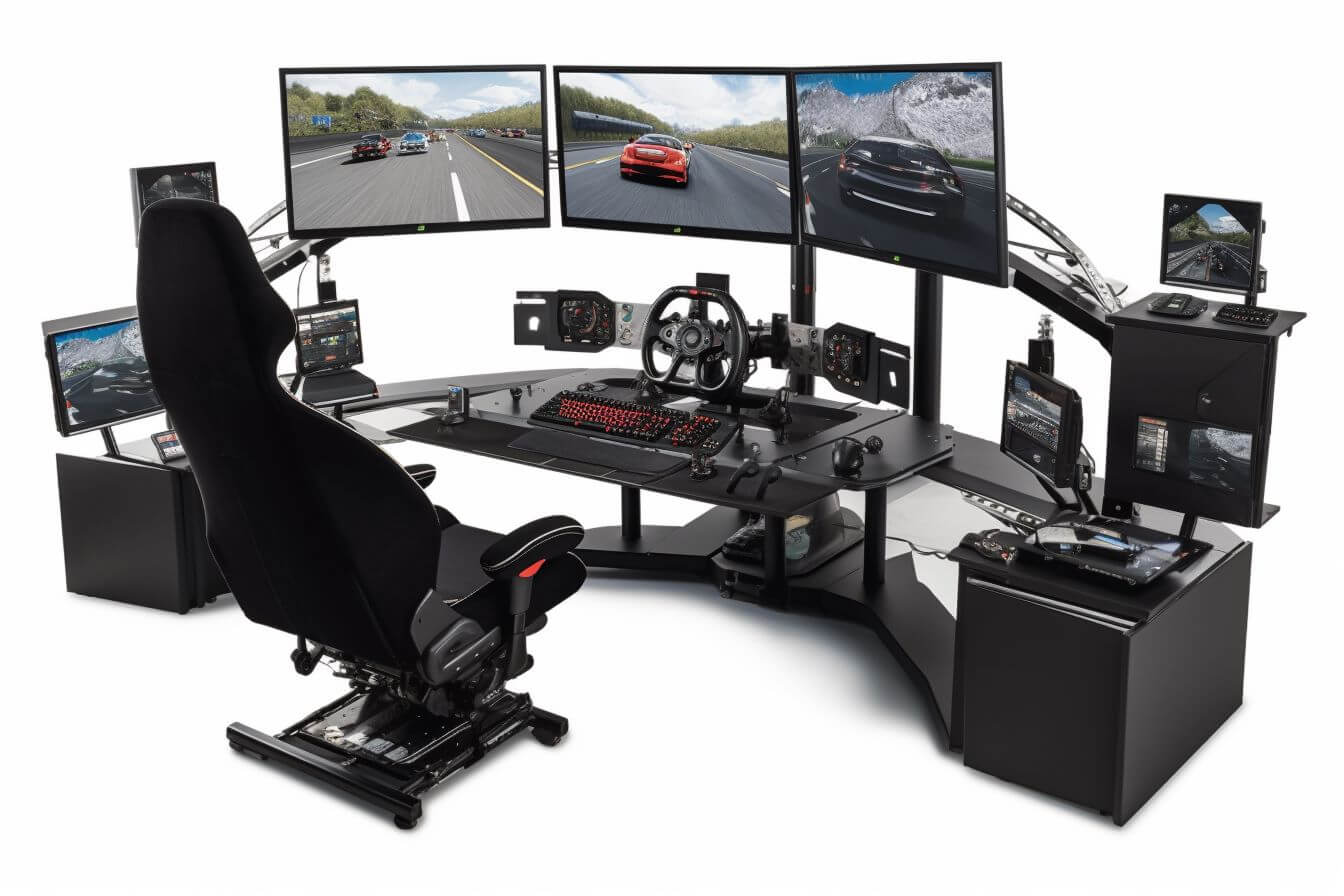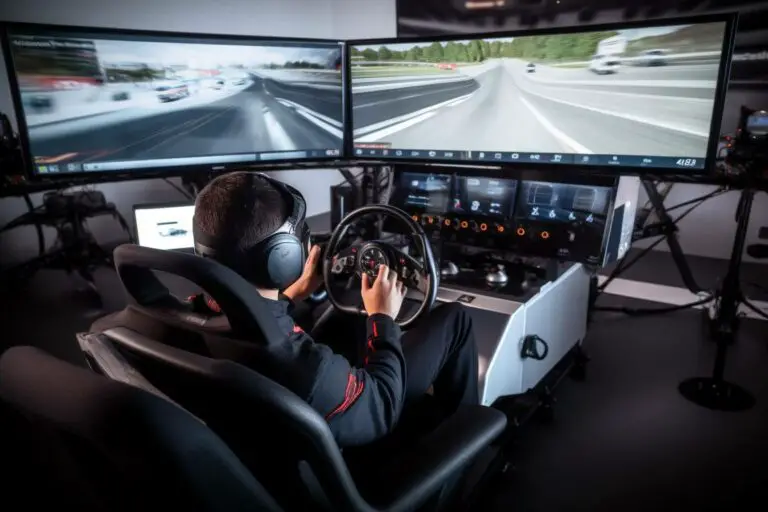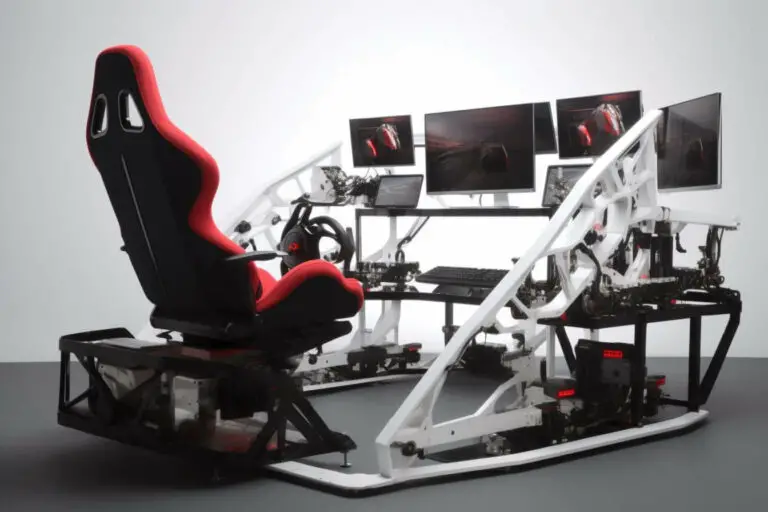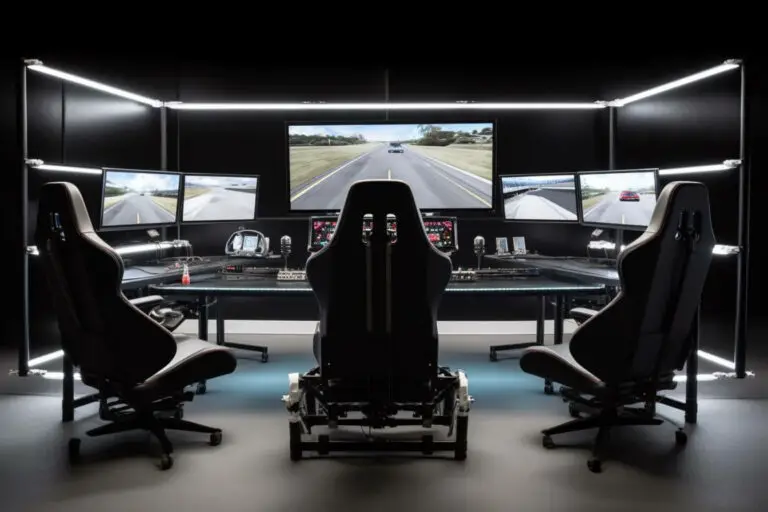How To Analyze Telemetry Data To Unlock Your Full Sim Racing Potential
How To Analyze Telemetry Data To Unlock Your Full Sim Racing Potential
- How To Analyze Telemetry Data To Unlock Your Full Sim Racing Potential
- The Importance Of Telemetry In Sim Racing
- Gathering And Recording Telemetry Information
- Identifying Key Metrics For Improvement
- Utilizing Software Tools For Data Analysis
- Interpreting And Understanding The Results
- Implementing Changes To Enhance Performance
- Monitoring Progress And Ongoing Data Analysis
- Frequently Asked Questions
- How Can I Ensure The Accuracy And Reliability Of The Telemetry Data I Collect During Sim Racing Sessions?
- Are There Any Specific Hardware Or Accessories I Should Invest In To Optimize The Quality Of Telemetry Data Gathered From My Sim Racing Setup?
- How Can I Effectively Compare My Telemetry Data With That Of Other Sim Racers To Identify Areas Where I Can Improve My Performance?
- What Are Some Common Pitfalls Or Mistakes Sim Racers Make When Analyzing Their Telemetry Data, And How Can I Avoid Them?
- How Can I Maintain My Motivation And Focus On Improvement When The Telemetry Data Analysis Process Becomes Overwhelming Or Tedious?
- Conclusion
Are you tired of watching others zoom past you on the virtual racetrack? Have you been struggling to find that extra edge to push your sim racing performance to new heights? It’s time to unlock your full potential, and we’ve got just the tool for you – telemetry data.
By analyzing this treasure trove of information, you’ll be able to pinpoint areas where you can improve and fine-tune your driving skills like never before.
So what exactly is telemetry data? In a nutshell, it’s all those juicy details about your car’s performance during a race: speed, throttle input, brake pressure, tire wear, suspension behavior – the list goes on.
With today’s advanced software tools at our disposal, there’s no need to feel overwhelmed by these complex data sets; in fact, understanding them is easier than ever! Keep reading as we delve into how best to analyze telemetry data and unleash the true sim racer within you.
Other Interesting Articles to improve your Sim Racing Techniques
How To Improve Your Sim Racing Lap Times: Shave Seconds Off Your Lap Time
What Are the Top Techniques to Master Corners in Sim Racing?
How Can I Optimize My Car Setup for Faster Lap Times in Sim Racing?
Discover the Insider Tips for Smoother Braking and Acceleration in Sim Racing
Which Driving Aids Can Help You Become a Faster Sim Racer?
How to Consistently Hit the Perfect Racing Line for Ultimate Speed
What Can You Learn from Pro Sim Racers to Boost Your Performance?
Uncover the Mental Strategies to Stay Focused and Improve Your Sim Racing Skills
How to Train Your Way to Sim Racing Greatness: Tips, Tricks, and Techniques
The Importance Of Telemetry In Sim Racing
Have you ever wondered how professional sim racers manage to shave off those extra few tenths of a second and consistently perform at the highest level?
The answer lies in their ability to analyze telemetry data. Telemetry is an essential tool for any sim racer looking to improve their performance, as it provides detailed information about your driving style, vehicle setup, and track conditions.
By delving into this wealth of data, drivers can identify areas where they may be losing time and make informed decisions on how to rectify these issues. This could involve tweaking car setups to optimize handling or focusing on specific aspects of their driving technique that need improvement.
Analyzing telemetry also allows sim racers to compare their laps with those of faster drivers, highlighting differences in approach and ultimately helping them learn from the best.
The importance of telemetry cannot be overstated; it has become a crucial component in the pursuit of success within the world of sim racing. It’s not just about setting fast lap times – mastering this skill will enable you to adapt more quickly when faced with changing track conditions or new vehicles while ensuring consistent performances throughout race events.
By investing time into understanding and utilizing telemetry data effectively, you’ll unlock your full potential as a sim racer and gain a competitive edge over your rivals.
Gathering And Recording Telemetry Information
Now that we’ve delved into the significance of telemetry in sim racing, it’s crucial to understand how to gather and record this valuable data effectively. Telemetry information provides essential insights into your performance on the track and helps you identify areas for improvement. To make the most out of telemetry, you must first learn how to collect and store this data efficiently.
To gather robust telemetry data, consider using specialized hardware and software designed explicitly for sim racers. These tools will allow you to access a wealth of information about your driving dynamics, including speed, gear changes, throttle position, brake pressure, tire temperatures, lap times, and more.
Some popular options include:
- Sim Racing Hardware:
- USB Data Acquisition Systems
- Load Cell Brake Pedals
- GPS Lap Timers
- Software Solutions:
- iRacing Telemetry Analysis Tools (e.g., Virtual Racing School)
- MoTeC i2 Pro
- Z1 Analyzer
After collecting comprehensive telemetry data during your races or practice sessions, organize and store it systematically so that analyzing patterns becomes seamless. Create folders with specific labels like car type, track name or event date to keep things tidy.
Furthermore, utilize software solutions mentioned earlier to visualize trends and pinpoint areas where improvements are needed. The key is not only having rich telemetry information at hand but also understanding how to interpret that data correctly.
Taking full advantage of gathered telemetry information can unlock your true potential as a sim racer by providing detailed feedback on every aspect of your driving style. By identifying weaknesses such as inefficient braking points or inconsistent cornering techniques through analysis of collected data sets, drivers have an opportunity for targeted training sessions aimed at addressing these issues head-on resulting in improved overall performance around circuitry worldwide!
Don’t let raw talent alone dictate success; instead harness power provided by advanced analytics found within world-class simulation environments today across globe right now…you won’t be disappointed, as it will lead to optimized solutions, increased efficiency, and a competitive edge in the ever-evolving technological landscape.
Identifying Key Metrics For Improvement
Behold the power of data! It’s time to delve into the key metrics that will unlock your sim racing potential. By identifying these crucial aspects, you can focus on specific areas for improvement and ultimately achieve your goals in the virtual racing world.
The table below highlights some essential telemetry data points that play a vital role in enhancing your performance:
| Metric | Description | Impact on Performance |
|---|---|---|
| Throttle/Brake Input | Measures how much throttle or brake is being applied at any given moment | Acceleration & Braking Efficiency |
| Steering Angle | Shows the amount of steering input (in degrees) provided by the driver | Cornering Ability |
| Speed | Indicates the vehicles speed throughout each section of the track | Overall Lap Time |
| Lateral/Longitudinal Gs | Displays lateral and longitudinal G-forces experienced during cornering, acceleration, and braking | Vehicle Stability |
By paying close attention to these data points, you’ll gain valuable insights about many facets of your driving style. For instance, analyzing throttle and brake inputs can help identify if you’re under- or over-utilizing either pedal; this information could lead to smoother accelerations and more efficient braking zones. Monitoring steering angle allows you to pinpoint instances where excessive or insufficient input may be hindering your cornering ability. Additionally, examining vehicle speed can reveal opportunities for better gear selection or improved racing lines.
So there you have it – armed with knowledge about these critical metrics, you’re well-equipped to embark on a journey toward sim racing excellence. Regularly reviewing and comparing telemetry from various sessions will only serve to sharpen your skills even further. So waste no time: harness the full power of data analysis today and leave your competition in the dust!
Utilizing Software Tools For Data Analysis
Having understood the importance of identifying key metrics for improvement, it is now time to delve into how you can utilize software tools to analyze and interpret telemetry data effectively. These tools not only allow you to dissect your sim racing performance thoroughly but also enable you to implement necessary changes that help refine your technique further.
There are numerous software applications available in the market that cater specifically to sim racers’ needs when analyzing their telemetry data. Some popular options include iSpeed, MoTeC i2, Z1 Analyzer, and Virtual Racing School (VRS).
Each tool offers its unique set of features and capabilities; therefore, researching and choosing a suitable application based on your requirements is crucial. Common functionalities provided by these tools include comparing lap times, sector times, braking points, gear shifts, steering angles, and even tire wear across different laps or sessions. Additionally, some advanced applications offer driver coaching services through virtual classrooms where experts provide personalized guidance using analyzed data.
When selecting an appropriate software tool for data analysis, consider factors such as compatibility with your preferred simulator game(s), user interface friendliness, comprehensive reporting options, pricing structure (free vs. paid), community support forums availability (for troubleshooting issues or learning from peers), and potential future development/upgrades roadmap.
By leveraging the power of these specialized software applications combined with knowledge gleaned from key metric identification techniques discussed earlier in this article series—you will be well-equipped to take control of your sim racing journey toward unlocking previously unattainable skill levels!
Interpreting And Understanding The Results
Data visualization is key to understanding the performance metrics of your sim racing.
It’s important to be able to interpret the data in order to identify any potential areas for improvement.
Performance metrics can help you determine the areas you need to focus on to gain the best results.
Being able to interpret and understand the data can help you unlock your full sim racing potential.
Data Visualization
Data visualization, now that’s where the magic really happens! It’s all about turning raw telemetry data into something visually appealing and easy to understand.
You see, our brains are wired to process visual information much faster than text or numbers. So when we’re presented with graphs and charts, it becomes easier for us to spot patterns, trends, and anomalies in our sim racing performance.
In order to make sense of your telemetry data, you’ll want to use specialized software tools designed specifically for this purpose. Many popular sim racing titles offer built-in data analysis features or support third-party applications like MoTeC i2 or Z1 Analyzer.
These programs allow you to dive deep into the specifics of each lap: throttle inputs, braking points, steering angles – you name it! By comparing different laps side by side using these visualization tools, you can quickly identify areas where improvements can be made and begin working on fine-tuning your driving technique.
So go ahead and embrace your inner race engineer! Analyzing telemetry data through data visualization is an essential step towards unlocking your full potential as a sim racer.
Just imagine being able to shave off those precious tenths or even hundredths of a second from your lap times simply by adjusting how early or late you brake going into a corner. The power of understanding what goes on behind every turn of the wheel lies right at your fingertips with the help of these advanced yet user-friendly tools.
Go out there, experiment with different setups and strategies based on your newfound knowledge, and watch yourself climb up the leaderboards!
Performance Metrics
As you delve into the realm of data visualization and analysis, it’s crucial to familiarize yourself with various performance metrics that can help fine-tune your sim racing skills. These metrics provide valuable insights into specific aspects of your driving technique and car setup, allowing you to pinpoint areas where adjustments might be necessary.
It’s not just about analyzing raw telemetry data; understanding these key performance indicators is equally essential in making sense of what goes on behind every lap. Some common performance metrics include:
- Corner entry speed
- Apex speed
- Exit speed
- Lateral G-forces
- Longitudinal G-forces
- Throttle position
- Brake pressure
- Steering angle
- Tire temperature
By monitoring these parameters closely and comparing them across different laps or setups, you’ll gain a better understanding of how certain changes affect your overall performance on the track. For instance, if you notice excessive understeer during high-speed corners due to low front tire temperatures, adjusting camber settings could lead to improved grip levels and faster lap times.
Don’t forget that practice makes perfect – as you continue working with these performance metrics and their corresponding visualizations over time, you’ll become more adept at identifying patterns and trends that contribute to an optimized driving style. So keep experimenting with new techniques based on this invaluable information while remembering that patience pays off when it comes to mastering the art of interpreting telemetry data for sim racing success!
Implementing Changes To Enhance Performance
Now that you’ve acquired and analyzed your telemetry data, it’s time to implement changes to take your sim racing performance to the next level. You may find various areas for improvement in your driving technique, car setup, or even hardware adjustments. Don’t be afraid of making these necessary alterations; they will ultimately help you unlock your full potential as a sim racer.
- Driving Technique: Are there specific corners where you consistently lose time? Focus on improving those areas by experimenting with different approaches – brake earlier, trail brake more effectively, or adjust your turn-in points.
- Car Setup: Review the balance between understeer and oversteer during cornering. Make incremental changes to parameters such as suspension stiffness or tire pressures until you achieve optimal handling characteristics that suit your driving style.
- Hardware Adjustments: If possible, fine-tune the force feedback settings on your wheelbase or pedals since this can have a significant impact on immersion and driver feel. Ensure that everything is calibrated correctly so that inputs are accurately translated into the virtual environment.
As we wrap up our discussion about utilizing telemetry data to boost performance in sim racing, remember that consistency is key when applying any modifications. Do not expect overnight success – instead, dedicate yourself to practice sessions where you focus solely on implementing these new insights one step at a time.
By doing so, not only will you become faster but also develop an innate understanding of how each tweak affects overall lap times and vehicle dynamics. Embrace the process of learning from telemetry analysis; eventually, you’ll emerge as a more confident and capable sim racer than ever before!
Monitoring Progress And Ongoing Data Analysis
Like a fine wine developing its flavors over time, monitoring your progress and ongoing data analysis in sim racing is an essential part of the journey to unlocking your full potential. This continuous process will help you hone your skills on the track and identify areas for improvement. Remember that Rome wasn’t built in a day – becoming a master at analyzing telemetry data takes patience, dedication, and practice.
While reviewing your performance after each race or training session, it’s crucial to compare various aspects of your driving with previous sessions. One way to keep track of this comparison is by creating a table where you can note down key metrics from different sessions:
| Session | Lap Time | Top Speed | Braking Points | Cornering G-Force |
|---|---|---|---|---|
| 1 | 2:03 | 315 km/h | T3 – 100m | 4G |
| 2 | 2:01 | 317 km/h | T3 – 110m | 4.5G |
| 3 | :59 | _ | 32_0 km/h_ _ | T_3–120_m |
The above table showcases how you might record improvements such as faster lap times, higher top speeds, better braking points, and increased cornering forces over multiple sessions. By comparing these values regularly, you’ll be able to spot trends indicating whether specific changes are beneficial or detrimental to your overall performance.
Monitoring progress shouldn’t end when stepping out of the simulator; make sure to study relevant online resources and join sim racing communities where experienced racers share their knowledge about telemetry analysis techniques. Always remember that learning never stops – even seasoned drivers constantly analyze data and refine their strategies accordingly. As long as there’s room for growth in any aspect of sim racing, don’t hesitate to continue delving into the wealth of telemetry data to unleash your full potential on and off the virtual track.
Frequently Asked Questions
How Can I Ensure The Accuracy And Reliability Of The Telemetry Data I Collect During Sim Racing Sessions?
To ensure the accuracy and reliability of telemetry data collected during sim racing sessions, it’s crucial to use a trusted software tool or application specifically designed for such analysis.
Make sure your sim racing platform is compatible with the chosen program and that all necessary in-game settings are properly configured.
Additionally, regular maintenance of your gaming rig, including hardware calibration and firmware updates, can help maintain accurate readings.
Remember to consistently follow any recommended best practices when gathering data, allowing you to confidently rely on the information obtained for performance improvement purposes.
Are There Any Specific Hardware Or Accessories I Should Invest In To Optimize The Quality Of Telemetry Data Gathered From My Sim Racing Setup?
Back in the day, sim racers relied on basic equipment to gather data from their racing sessions. However, investing in specific hardware and accessories can greatly optimize the quality of telemetry data gathered from your sim racing setup today.
High-quality wheel and pedal sets with load cell brake pedals offer more precise input data, while motion platforms or tactile feedback systems like butt-kickers provide enhanced output for realistic force feedback.
Moreover, consider purchasing a dedicated USB data logger that captures accurate lap time information and other essential telemetry details directly from your rig’s sensors.
By upgrading your gear, you’ll ensure top-notch accuracy and reliability when analyzing your performance during sim racing sessions.
How Can I Effectively Compare My Telemetry Data With That Of Other Sim Racers To Identify Areas Where I Can Improve My Performance?
To effectively compare your telemetry data with that of other sim racers and identify areas for improvement, you can use specialized software tools designed to analyze and visualize the data.
These tools allow you to overlay multiple drivers’ laps, highlighting differences in driving lines, braking points, gear shifts, and throttle application.
By studying these variations closely, you’ll be able to pinpoint specific sections where you might gain time or improve consistency.
Additionally, joining online forums or communities dedicated to sim racing can provide valuable insights from fellow racers who may offer advice or share their own telemetry data for comparison purposes.
What Are Some Common Pitfalls Or Mistakes Sim Racers Make When Analyzing Their Telemetry Data, And How Can I Avoid Them?
Navigating the world of telemetry data can feel like trying to find a needle in a haystack, especially when it comes to identifying mistakes and pitfalls sim racers commonly fall into.
One such pitfall is focusing solely on lap times instead of analyzing specific areas of performance; this can lead to overlooking valuable information that could help improve your skills.
Additionally, comparing yourself only with the top performers may demotivate you rather than motivate for growth – it’s important to compare against racers at various skill levels to gauge realistic progress.
Lastly, many sim racers fail to recognize patterns in their data or neglect minor issues that accumulate over time.
To avoid these common missteps, make sure you have a well-rounded approach: analyze individual sections of laps, compare with different level racers, and pay attention to both large and small details within your telemetry readings.
How Can I Maintain My Motivation And Focus On Improvement When The Telemetry Data Analysis Process Becomes Overwhelming Or Tedious?
Maintaining motivation and focus on improvement when analyzing telemetry data becomes overwhelming or tedious can be achieved by setting small, achievable goals for yourself and celebrating your progress along the way.
Break down complex tasks into manageable steps, and remember to take breaks when needed to avoid burnout.
Keep in mind that patience is key, as mastery takes time and consistent effort.
Surrounding yourself with a supportive community of fellow sim racers can also help maintain motivation through shared experiences and encouragement from others who understand the challenges you face in refining your skills.
Conclusion
In conclusion, it’s quite amusing how we can become so consumed by the data-driven world of sim racing that we forget the pure joy and adrenaline rush of being behind the wheel.
It’s as if our quest for perfection overshadows what drew us to this virtual sport in the first place.
So let’s not lose sight of why we started sim racing; embrace the challenge, learn from telemetry data, but never forget to enjoy every twist and turn along the way.
After all, isn’t that what truly fuels our passion?








